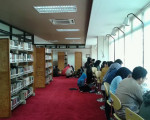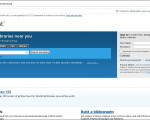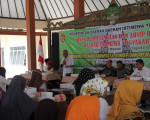Type of Library Services
Writer:
Hendrikus Franz Josef, M.Si
Regional Library and Archive Office of
2019
Abstract
According to Law No. 43 of 2007, libraries are institutions that manage the collection of written works, printed works, and recorded works in a professional manner with a standardized system to meet the education, research, preservation, information, and recreation needs of the library users. The library is held based on the principles of lifelong learning, democracy, justice, professionalism, openness, measurement, and partnership. The library functions as a vehicle for education, research, preservation, information, and recreation to increase the intelligence and empowerment of the nation. The library aims to provide services to users, increase reading fondness, and expand insight and knowledge to educate the nation's life. From the description above, there is one common thread that can be drawn that the library is a place to serve information through the collection of library materials that it has. The existence of a library is to empower people to have good information awareness. Awareness of the importance of information is what is commonly referred to as information literacy. The absence of a unified library structure is evidence that the institutional aspects of the library are very fragile. As is known together between the national library, provincial library, and public library there is no structural coordination, but limited to functional coordination. Not to mention the school and tertiary libraries which are under the authority of the Department / Department of National Education. The weak institutional aspect will have an impact in the form of a minimum budget allocated by the government in the library field. In fact, not a few libraries are supported with a zero budget. Although the Library Law requires each school to allocate a minimum of five percent of the budget to the library, the reality on the ground is almost no change. Librarians are the spearhead for the success of a library in increasing public interest in reading. But this profession apparently has not received proper attention from the government (especially local governments). In every recruitment of civil servants, it is rare for local governments in
Preface
Literacy has an important function in life. Iterated awareness will usher in a position of civilization. A literate nation is a nation that is able to answer the challenges of the times. Conversely, a nation that is not literate will transform into a weak nation. This weak nation will never be able to respond to challenges and obstacles in the future. Literacy itself is simply interpreted as the ability to read and write.
In the context of community empowerment, literacy means the ability to obtain information and use it to develop knowledge that is beneficial to society. Civilized culture is always marked by a high concern for the library. The library has always been a literacy transportation when a civilization reaches its golden peak. The history of the development of science and technology throughout human civilization cannot be separated from the library. Not just anyone can work as a librarian. Only people who already have library science requirements can work. Information literacy is the soul of a library. The National Library of the
The five supporting bases, and the five radiating lights symbolize the basic philosophy of Pancasila in science to produce a complete Indonesian human being that is useful for the homeland and the nation. Determination in an effort to realize equitable education for all the people of
Type of Library Services
In the world of libraries and librarians, there are two kinds of library services, namely technical services and user services. What is meant by technical service is a service that involves the work in preparing a books that later the book can be used by library users. While user services are library activities in providing services to library users, especially to the members of the library. Because this technical service has already been discussed in The library Material Processing, this paper will only discuss user services. The number / types of library user services that can be provided to the library are actually quite a lot. However, all of these services must be adjusted according to the conditions of the wedding staff and the needs of its users. The types of user service, among others, can be mentioned as follows:
1). Circulation services;
2) Reference service;
3) User education services;
4) Information retrieval service;
5) Latest information dissemination services;
6) Selected information dissemination services;
7) Translation services;
8) Photocopy services or Digital Softcopy;
9) And others.
In its implementation, these services are often grouped into two types, namely Circulation Services and Reference Services. Thus, other services can be integrated into circulation services and reference services.
.
There are two types of service systems commonly used by the libraries, namely open service systems and closed service systems. Each of these systems have advantages and disadvantages.
1). Open Access System.
In an open service system the library gives freedom trousers can enter and choose their own collection from the shelf. The clerk only records if the collection will be borrowed and returned. The advantages: Users are free to choose their book This freedom creates an incentive to read If the desired book does not exist, can choose another book with the subject or same topic. The disadvantage: The arrangement of books on a shelf becomes difficult to organize. Likely many books are missing..
2). Closed Service System.
Contrary to open systems, visitors cannot enter the collection room, but what he needs must be taken by the officer. Search / search collections must go through a catalog. Officers in addition to recording loans and repayments, also retrieve and return the collection to the shelf.
The advantages: The composition and location of the books are maintained There is no need for special personnel to supervise users. The
disadvantages: freedom to see the book does not exist, must be searched through the catalog, viewing from a catalog is sometimes frustrating, because in a catalog, but the mother often doesn't, and has to choose again and again,
officers must get and return books and catalog must be complete.
Circulation Services
Circulation service is a service that concerns the circulation of library materials owned by the library. In this circulation service, the process of borrowing library materials that may be borrowed, determining the period of borrowing, returning library materials borrowed and making loan statistics to make library reports. The types of collections lent are usually limited to printed materials. But there are also libraries that lend non-book material such as audio cassettes, video cassettes, Compact Discs and others. Not all printed materials are loaned out. The types of library materials that are commonly lent are textbooks.
There are also libraries that lend old magazines (back issues). Loans are usually limited to library members, in this case people who are not library members may not borrow. They are only allowed to read on the spot. The loan period varies from one library to another library. Also between one book group with another book group. Generally the library lends book collections for two weeks for ordinary book collections and one day (nights) for reserved books. To speed up the work of the circulation section, it is necessary to make a manual which has information about: Rules for the use of library materials; Various types of library materials that may and may not be borrowed ;; The period of the loan, the amount of the fine if it is late to return; destroy borrowed books; Description of library opening hours; Information about the mark on the collection; Other information deemed necessary.
The circulation section performs the following tasks:
a. Keep an eye on library entrances and exits;
b. Member registration, membership renewal and resignation
library members (free from library loans);
c. Lend and return books and extend borrowing time;
d. Withdraw fines for books that are returned late. The clerk must make it
receipt of fines, if there are users who are fined;
e. Issue a warning letter for books that have not been returned in time;
f. Duties related to borrowing books, especially missing or damaged books;
g. Responsible for all borrower's files, such as member files, files
borrowers, late money, lost and damaged books, lost books, and is
responsible for the guest book and visit list;
h. Make loan statistics that are useful to know every day, new members,
members who resign, the number of books borrowed grouped by subject
(classification), number of borrowers who grouped according to the
interests of the library
i. Inter-library borrowing
j. Oversee the affairs of bags, coat suits and so on owned by visitors
library
k. Another task is to return books that have been read into shelves.
In library services there are several lending systems, namely:
a. General Ledger System.
This system adheres to a register, meaning that each borrower gets one-page allotment. Or more in the ledger, accompanied by the borrower's name index in the section the end of the ledger. On each page of the ledger there is a column for the borrower's name, address, borrow date, book call number, author, title, signature the borrower, the date must return,. Every time a borrower borrows a book, then the borrowed book's information along with the borrowed date and date must be re-recorded in the ledger, then signed. This system can only be applied to small libraries.
b. Dummy System.
Dummy system or dummy system in English, using a replacement. Made of cardboard as a book substitution when the book is borrowed.
c. NCR (No Carbon Required) system.
In this system the borrower needs to fill in the loan form complete with name, address, author's name, title, call number on the loan form. The loan form uses special paper that directly copies, even if it does not use carbon. Because it is called NCR or No Carbon Required. The amount of carbon paper depends on the policies of each library.
d. Book Issue Card System (BIC)
There are two variations of the BIC system, each using a 7.5 X 12.5 cm card. In the first system, at the top of the card the words "author" and "title" are written. At the bottom of the "author" and "title" column is written "date"
and "borrower's name". The second method uses cards too. At the top printed the information "name" and "shape". The column will be filled by the officer with the borrower's name. At the bottom are listed the date and book that was filled at the time of borrowing. This system is widely used in school libraries.
e. Browne system
Each library member gets a reader ticket, the same amount with the number of books that library members can borrow. Member ticket, name, and address are typed on each ticket. Ticket reader shaped a bag. To accompany a book ticket requires a book card, containing the calling number, master number, author, title, edition, and year of publication. This book card is inserted into a book bag, placed at the end of the book on the inside. Date labels or date slips are again placed at the end of the book, usually face to face with a book bag. On the date slip the parent number is written and call number. If the borrower wants to borrow, the clerk revokes the card a book from a book bag is then inserted into the ticket reader. The date must be
Return the feed on the date slip. The book bags are then arranged according to date must return. If on the same date there are various book bags, the book bags are arranged according to call numbers. If a member returns the borrowed book, the location of the book card is searched by the date on the date slip. Book tickets are then returned to the bag.
f. Islington System (Browne Variation).
The equipment needed is an embossing machine), plastic cards (each member receives 1 card), paper clips, labels date on each book, book bag. Each member gets one plastic card, at the top written name and address in embossed letters. The borrowing process is the same as the Browne system, only the borrower must attach the membership card to the book card with special printing equipment. This tool pressing the plastic on the book card so that the book card says the borrower's name. This system is relatively expensive, because it uses embossed lettering machine equipment.
g. Newark's system.
Library members obtain loan cards. The borrower's card contains the name, address, registration number, membership card expiration date, and date column must return. The member card must be carried when borrowing or return the book. Like the Browne system, the Newark system too using book cards, book pockets, and date slips back.
h. Charging Token.
For this purpose a member card is used, one card for a member with a validity period of one year. “Token” means a type of card containing a sign library identifiers made of cardboard sized 4 × 6 cm or more.
i. Punched Card System.
`The equipment needed is a computer or other technical sorting machine automatic guessing, membership cards made of plastic (one card for each member), punched cards, two cards for each borrowed book, and book bags for each book.
j. Photo charging or photo-based lending.
The tools needed are “photo charging” machines, computers, micro film reading devices, membership card (one card per member) and transaction card. Usually a set consists of several colors, book bags and labels on each book. This label contains information about the parent number, author and title, but does not contain column for date.
k. Computer-based loan system.
This type of lending system is a cutting-edge thief system at the moment this. The equipment needed is of course both computer hardware and software. At present there are many libraries that use lending systems computer based. The advantage is that transactions can be done quickly. Besides that, from one transaction, many outputs can be done, such as statistics loans, bills, loan checks of each member or even trace the book borrowed by whom. Data collection and member data has usually been inputted into the computer first. Transactions carried out in a way read barcodes (barcodes) with special reading tools on the membership card library and collection of books to be borrowed.
Conclusion
The library functions as one of the factors that accelerates the acceleration of the transfer of knowledge, therefore, the library is an inseparable unit in the education system of an institution. In addition, the library functions as a source of information, and is an important support for scientific research, as a reference or reference. Seeing the function of library that is so important, it should be noted by librarians or library users that the library should be able to balance the development of science, technology, culture and various other aspects, therefore, the impression of the library as an ancient institution must begin to be eroded, including problems library services which must start user-oriented services.
Services in an ideal library can be more attractive, friendly, fast, and accurate, this means that library service orientation must be based on user needs, anticipating the development of information technology and friendly service, in other words placing the user as one of the important factors influencing policy on a library, the impression of feudal services in a library must be erased, so that the library feels more humane. In general, services in the library can be interpreted as an activity or activities in providing services to library users without distinguishing social status, economy, trust or other status.
Bibliography
Buckland, Michael Keeble, Michael Gorman, and Michael Gorman. Redesigning library services: a manifesto.
Bingsi, Fan, and Hu Xiaojing, Library 2.0: Building the New Library Services, Journal of Academic Libraries 1 (2006);
.
Bolan, Kimberly, M. Canada, and R. Cullin, Web, Library, and Teen Services 2.0, Young Adult Library Services 5.2, (2007;
Seadle, Michael, and Louise L. Rutherford, Building Participative Library Services: the Impact of Social Software Use in Public Libraries, Library Hi Tech, 2008;
Rukmana, Evi Nursanti, Ninis Agustini Damayani, and Pawit M. Yusup, Kegiatan Pelayanan Perpustakaan di Perpustakaan Batu Api (studi kasus mengenai proses pelayanan perpustakaan dan jenis pelayanan di Perpustakaan Batu Api), Jurnal Kajian Informasi & Perpustakaan 3.2, 2015;
Vaillancourt, Renee J. Bare Bones, Young Adult Services: Tips for Public Library Generalists,
Perpustakaan Lainnya
 Hadapi Revolusi Industri 4.0, Perpustakaan Dituntut Bertransformasi
Hadapi Revolusi Industri 4.0, Perpustakaan Dituntut Bertransformasi
Menghadapi revolusi industri 4.0 dengan era digitalisasi, perpustakaan pun harus beradaptasi atas perkembangan zaman. Sebab...
 Wordcat: Pengkatalogan Online Dunia
Wordcat: Pengkatalogan Online Dunia
Wordcat: Pengkatalogan Online Dunia (www.worldcat.org) WorldCat adalah database informasi kleksi perpustakaanterlengkap di...
 Bedah Buku : “Kebijakan Pembangunan Destinasi Pariwisata Konsep dan Aplikasinya di Indonesia”
Bedah Buku : “Kebijakan Pembangunan Destinasi Pariwisata Konsep dan Aplikasinya di Indonesia”
Yogyakarta memiliki daya tarik yang tinggi terutama dalam bidang pariwisatanya. Banyaknya potensi tempat wisata baru yang dapat...
 Layanan Khasanah Arsip
Layanan Khasanah Arsip
Khasanah arsip merupakan layanan pencarian khasanah arsip yang dimiliki Kantor Arsip Daerah Provinsi Daerah Istimewa Yogyakarta...

 Penyerahan Buku KCKR dari Lintang Pustaka Utama
Penyerahan Buku KCKR dari Lintang Pustaka Utama